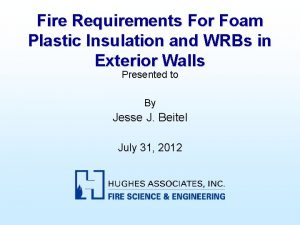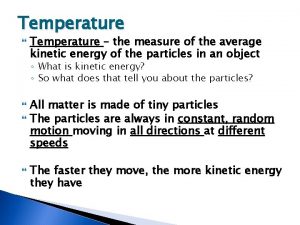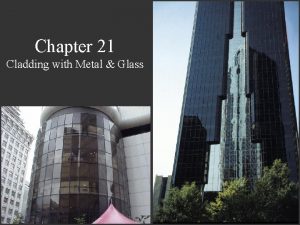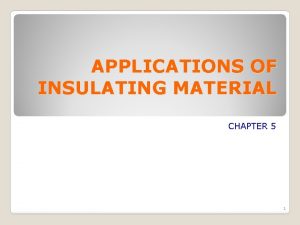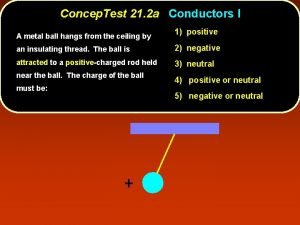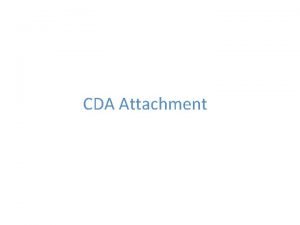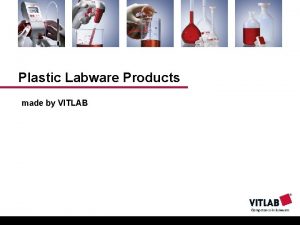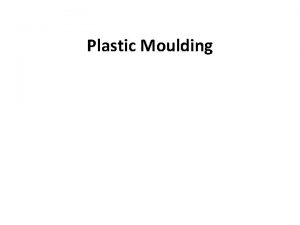CLADDING ATTACHMENT Foam Plastic Insulating Sheathing FPIS Products














- Slides: 14

CLADDING ATTACHMENT

Foam Plastic Insulating Sheathing (FPIS) Products: • Exterior wall coverings are attached directly through the FPIS into the framing or to furring attached through the FPIS to framing. • Shall be installed in accordance with: • Code compliance requirements per TER 1303 -04 • How to Install FPIS Installation Guide • Manufacturer’s installation instructions • The following general installation guidelines

Step 1: Verify FPIS and Framing • FPIS must have min compressive strength of 15 psi • Must comply with ANSI/SBCA FS 100 where wind pressure resistance is required ASTM D 1621 Note: Wind speeds shown in Table 1 are VASD. Where VULT is used, multiply wind speeds by a factor of 1. 26 _ + _

Step 1: Verify FPIS and Framing • Wood framing may be any softwood species with specific gravity 0. 42 or higher • Steel framing must be: Thickness Minimum Fb 33 mil, 43 mil 33 ksi 54 mil 50 ksi Fb

Step 2: Verify Fasteners Exterior coverings may be attached by the following methods: (a)Cladding (b)Fasteners (c) Furring (d)FPIS (e)Framing (f) Cavity Insulation (g)Interior wall finish (b) (a) (d) (e) (f) (g) Direct Attachment (a) (c) (d) (b) (e) (f) (g) Attachment through Furring

Step 2: Verify Fasteners • Fasteners must meet penetration requirements per IRC Table R 703. 3(1) into: 1¼” min or per manuf. instructions – Studs – Framing members • Where penetration into framing is not required, fasteners must extend ¼” beyond the opposite face of the sheathing per IRC Table R 703. 3. 2 1/4” min

Step 3: Place Insulation Boards • Ensure wall is square and true • Align boards with bottom edge of wall

Step 3: Place Insulation Boards • Verify stud spacing, blocking, and bracing requirements with manufacturer. • Provide framing or blocking for attachment of siding and trim at transitions – Seams should not be visible from interior unless allowed by manufacturer. 16” o. c. (or per manuf. )

Step 4: Attach Insulation Boards • Space fasteners per manufacturer’s instructions – Around edges of panel – Through panels and into interior members Interior Spacing Edge Spacing

Step 4: Attach Insulation Boards • Drive nails flush and snug • Do not over drive nails • Do not under drive nails – Exception: Leave 1/32” gap (or as required by manufacturer) to allow for lengthwise thermal expansion of vinyl or aluminum siding

Step 5: Trim Boards at Openings • Trim boards at all window and door openings • Cover all framing with FPIS • Fit joints tightly FPIS Continuous Insulation

Step 6: WRB and Flashing • Ensure that a codecompliant water resistive barrier (WRB) and required flashing is provided • If using FPIS as a WRB: – Seal all joints and openings and penetrations per manufacturer’s installation instructions

Step 6: WRB and Flashing • At pipe and other small penetrations, seal gaps with silicone or expanding spray foam sealant • Seal joints and openings with joint tape per manufacturer’s instructions FPIS Continuous Insulation

Step 6: WRB and Flashing • Repair damaged areas per manufacturer’s instructions
 Foam plastic insulation
Foam plastic insulation Measure of average kinetic energy
Measure of average kinetic energy Masonry veneer curtain walls:
Masonry veneer curtain walls: Iprs limited
Iprs limited Brittle cladding
Brittle cladding Cladding layer
Cladding layer Dmc explosion welding
Dmc explosion welding Column cover and spandrel system
Column cover and spandrel system Cladding deflection limits
Cladding deflection limits Plastic products projects in kerala
Plastic products projects in kerala Examples of functional and innovative products
Examples of functional and innovative products Pepsi product mix
Pepsi product mix Applications of insulating materials in transformers ppt
Applications of insulating materials in transformers ppt Polycarbonate process flow diagram
Polycarbonate process flow diagram Two neutral conductors are connected by a wire
Two neutral conductors are connected by a wire
